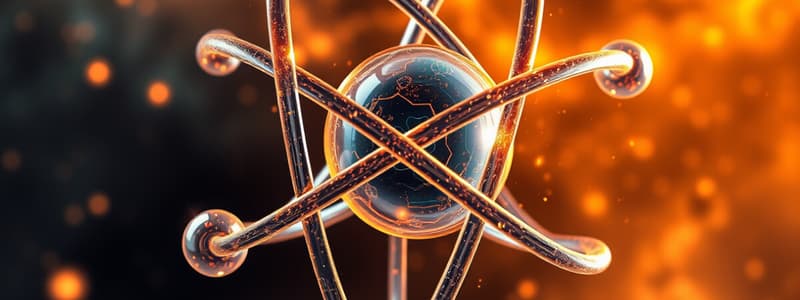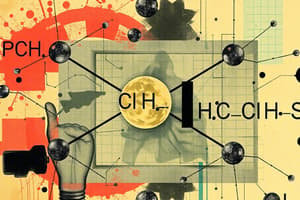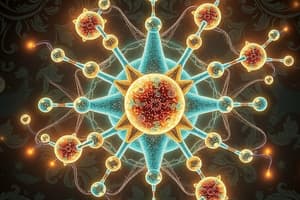Podcast
Questions and Answers
Which of the following statements about carbon bonds is true?
Which of the following statements about carbon bonds is true?
- Carbon atoms exhibit tetrahedral arrangement for their four single bonds. (correct)
- Carbon atoms can form multiple bonds with a maximum of three other atoms.
- Carbon can only form single bonds with hydrogen atoms.
- Carbon cannot form covalent bonds with sulfur.
What type of biomolecule does palmitic acid categorize as?
What type of biomolecule does palmitic acid categorize as?
- Amino acid
- Nucleotide
- Fatty acid (correct)
- Sugar
Which of the following nitrogenous bases is classified as a pyrimidine?
Which of the following nitrogenous bases is classified as a pyrimidine?
- Thymine (correct)
- Guanine
- Cytosine (correct)
- Adenine
Which sugars are specifically mentioned as part of two sugars in biomolecules?
Which sugars are specifically mentioned as part of two sugars in biomolecules?
What characteristic of double bonds affects molecular rotation?
What characteristic of double bonds affects molecular rotation?
Which of the following compounds is a sugar alcohol?
Which of the following compounds is a sugar alcohol?
What is the primary characteristic of covalent bonds?
What is the primary characteristic of covalent bonds?
Which element most commonly forms covalent bonds by sharing its four outer electrons?
Which element most commonly forms covalent bonds by sharing its four outer electrons?
What distinguishes a polar covalent bond from a non-polar covalent bond?
What distinguishes a polar covalent bond from a non-polar covalent bond?
What happens to covalent bonds when exposed to high temperatures?
What happens to covalent bonds when exposed to high temperatures?
In a water molecule, what charge does the oxygen atom carry compared to the hydrogen atoms?
In a water molecule, what charge does the oxygen atom carry compared to the hydrogen atoms?
Which of the following best describes the bonding situation in a non-polar covalent bond?
Which of the following best describes the bonding situation in a non-polar covalent bond?
How many hydrogen atoms can a single carbon atom bond with to fill its outer orbital?
How many hydrogen atoms can a single carbon atom bond with to fill its outer orbital?
Which statement about covalent bonds is incorrect?
Which statement about covalent bonds is incorrect?
What is likely to happen if a covalent bond is subjected to strong chemicals?
What is likely to happen if a covalent bond is subjected to strong chemicals?
Which building block is NOT part of the category of amino acids?
Which building block is NOT part of the category of amino acids?
What type of molecular organization primarily represents proteins within a cell?
What type of molecular organization primarily represents proteins within a cell?
What defines an anion in the context of ionic bonds?
What defines an anion in the context of ionic bonds?
What term describes ribosomes and enzyme complexes in the context of cellular organization?
What term describes ribosomes and enzyme complexes in the context of cellular organization?
Which statement correctly describes the formation of ionic bonds?
Which statement correctly describes the formation of ionic bonds?
Among the 20 amino acids, which of the following is classified as an aromatic amino acid?
Among the 20 amino acids, which of the following is classified as an aromatic amino acid?
In terms of molecular organization, which of the following options represents metabolic intermediates?
In terms of molecular organization, which of the following options represents metabolic intermediates?
How does the charge of a cation relate to the number of protons and electrons in an ion?
How does the charge of a cation relate to the number of protons and electrons in an ion?
What is characteristic of hydrogen bonds compared to ionic bonds?
What is characteristic of hydrogen bonds compared to ionic bonds?
Which of the following is not considered a precursor from the environment necessary for cellular functions?
Which of the following is not considered a precursor from the environment necessary for cellular functions?
What occurs when an ionic bond is formed?
What occurs when an ionic bond is formed?
What type of interaction primarily stabilizes the supramolecular complexes that include ribosomal proteins?
What type of interaction primarily stabilizes the supramolecular complexes that include ribosomal proteins?
How many nitrogenous bases are identified as primordial molecules?
How many nitrogenous bases are identified as primordial molecules?
What is the relationship between temperature and ionic bond stability?
What is the relationship between temperature and ionic bond stability?
Which of the following scenarios illustrates hydrogen bonding?
Which of the following scenarios illustrates hydrogen bonding?
Which of the following organelles is responsible for energy production in a cell?
Which of the following organelles is responsible for energy production in a cell?
What is the primary structural component of most cells, constituting over 50% of the dry weight?
What is the primary structural component of most cells, constituting over 50% of the dry weight?
What role does the superscript number play for ions?
What role does the superscript number play for ions?
How many hydrogen bonds can a single water molecule typically form?
How many hydrogen bonds can a single water molecule typically form?
What distinguishes intramolecular hydrogen bonds from intermolecular hydrogen bonds?
What distinguishes intramolecular hydrogen bonds from intermolecular hydrogen bonds?
Which of the following trace elements is not essential for the function of specific proteins?
Which of the following trace elements is not essential for the function of specific proteins?
Which monoatomic ion is crucial for the oxygen-transporting capacity of hemoglobin?
Which monoatomic ion is crucial for the oxygen-transporting capacity of hemoglobin?
What percentage of the mass of most cells is accounted for by the four most abundant elements?
What percentage of the mass of most cells is accounted for by the four most abundant elements?
Which element is the lightest and needs four electrons to form covalent bonds?
Which element is the lightest and needs four electrons to form covalent bonds?
Which of the following elements does not readily form covalent bonds by electron-pair sharing?
Which of the following elements does not readily form covalent bonds by electron-pair sharing?
How many trace elements are listed, essential for life, in the provided content?
How many trace elements are listed, essential for life, in the provided content?
Which of the following statements about the elements in living organisms is FALSE?
Which of the following statements about the elements in living organisms is FALSE?
Which trace element has a known role in oxygen transport and accounts for only 0.3% of hemoglobin's mass?
Which trace element has a known role in oxygen transport and accounts for only 0.3% of hemoglobin's mass?
Which of the following elements requires only one electron to achieve a full valence shell?
Which of the following elements requires only one electron to achieve a full valence shell?
Which element among the four most abundant elements in living organisms does NOT need two electrons to bond?
Which element among the four most abundant elements in living organisms does NOT need two electrons to bond?
Flashcards are hidden until you start studying
Study Notes
Covalent Bonds
- Atoms achieve stability by sharing electrons, filling their outer orbitals, forming strong covalent bonds.
- Covalent bonds are strong and do not break unless exposed to strong chemicals or high energy, typically heat.
- Bonds remain intact at temperatures compatible with life.
- Carbon, with four electrons, often participates in covalent bonding to fill its outer orbital to eight.
- Hydrogen has one electron and needs one more to fill its outer orbital, allowing carbon to bond with four hydrogen atoms.
Non-Polar and Polar Covalent Bonds
- Covalent bonds may show similar or different attractions for shared electrons.
- Non-Polar Covalent Bonds: Atoms exhibit similar attraction for electrons.
- Polar Covalent Bonds: One atom has a significantly greater attraction for electrons, leading to unequal sharing and resulting in partial positive and negative charges.
- Water is a polar molecule, with oxygen attracting shared electrons more than hydrogen, causing a slight negative charge on oxygen and slight positive charges on hydrogen.
Ionic Bonds
- Ionic bonds form by joining ions; one atom's electrons are strongly attracted by another atom, leading to complete transfer (loss or gain) without sharing.
- Charged atoms (ions): Anions (gain electrons, negatively charged) and Cations (lose electrons, positively charged).
- Ionic bonds are formed through the attraction between oppositely charged ions.
- Ionic bonds are generally weak and can be broken at room temperature.
Hydrogen Bonds
- Weak bonds arising from the electrostatic attraction between a positively charged hydrogen atom in one polar molecule and a negatively charged atom in another.
- For example, each water molecule can form hydrogen bonds with approximately four neighboring water molecules, creating a stable lattice structure.
- A single hydrogen bond is weak; however, many hydrogen bonds can create firm connections between molecules.
Four Most Abundant Elements in Living Organisms
- Comprise 99% of most cells' mass.
- Capable of forming multiple bonds and readily engage in covalent bonding.
- Key elements:
- Carbon (needs 4 electrons)
- Hydrogen (needs 1 electron)
- Oxygen (needs 2 electrons)
- Nitrogen (needs 3 electrons)
Molecular Organization Hierarchy
- Precursors: CO2, NH3, H2O, N2.
- Metabolic Intermediates: Pyruvate, malate, citrate, glyceraldehydes-3-phosphate.
- Building Blocks: Nucleotides, monosaccharides, glycerol, amino acids, fatty acids.
- Macromolecules: Nucleic acids, polysaccharides, proteins (over 50% of dry cell weight), lipids.
- Supramolecular Assemblies: Ribosomes, enzyme complexes.
- Organelles: Nucleus, chloroplasts, mitochondria, Golgi bodies.
- Supramolecular Complexes: Nucleic acids and proteins held together by weak non-covalent forces.
Primordial Molecules
- Composed of 20 amino acids, such as glycine, phenylalanine, and lysine.
- Include 5 nitrogenous bases, divided into pyrimidines (e.g., uracil, thymine) and purines (e.g., adenine, guanine).
- Contains one or more fatty acids (e.g., palmitic acid) and two sugars (e.g., α-D-glucose).
- Sugar alcohol: Glycerol.
- Nitrogenous alcohol: Choline.
Biomolecules
- Compounds primarily composed of carbon with various functional groups.
- Carbon forms single bonds with hydrogen and can create both single and double bonds with oxygen and nitrogen.
- Capable of forming stable carbon-carbon single bonds and up to four single bonds arranged tetrahedrally.
- Double bonds are shorter and more rigid, allowing limited rotation.
- Covalent bonding enables the formation of linear chains, branched chains, and cyclic structures in biomolecules.
Studying That Suits You
Use AI to generate personalized quizzes and flashcards to suit your learning preferences.




